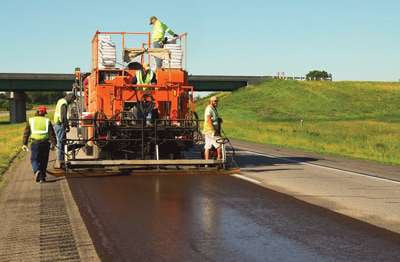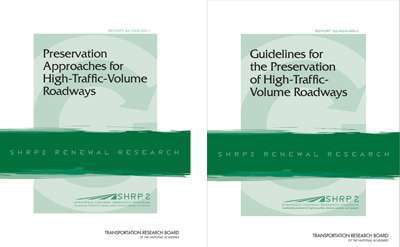 Micro Surfacing incorporating latex polymer modifier is placed on I-35 in Iowa
Micro Surfacing incorporating latex polymer modifier is placed on I-35 in IowaThe Federal Highway Administration and its allies among the state Departments of Transportation (DOTs) are leading a new emphasis on pavement preservation for high-volume, high-level highways like dual-lane federal routes and interstates.
With a goal of extending service life of high-traffic volume highways, and identifying suitable techniques and methods – buttressed by active research from a SHRP2 project, R26: Preservation of High-Traffic-Volume Roadways – the Federal Highway Administration (FHWA) is publicizing the benefits of select pavement preservation treatments for these critical highways. R26 is a nine-year program, for which the research is 90 percent complete, according to Thomas Van, FHWA pavement management engineer.
Currently,13 states – Minnesota, Wisconsin, Massachusetts, Maine, Washington State, Missouri, Pennsylvania, Arizona, Kentucky, Tennessee, Georgia, Delaware and Rhode Island, plus the District of Columbia – are participating in R26 projects. Ultimately, 135 projects in 38 states will be included in the $130 million budget.
Recently, two publications from the R26 project – Preservation Approaches for High-Traffic-Volume Roadways, and its companion report, Guidelines for the Preservation of High-Traffic-Volume Roadways – have received wide distribution, and provide a template for state DOTs and other pavement owners to justify and execute preservation techniques for high-volume roadways.
These publications represent the first methodical and wide-ranging elaboration of the process of pavement preservation for high traffic roads, and provide technical details and a structure for implementation of preservation for high volume highways. Both tomes were authored by D. Peshkin, K. L. Smith, A. Wolters and J. Krstulovich, Applied Pavement Technology, Urbana, Illinois, and J. Moulthrop and C. Alvarado, Fugro Consultants, Austin, Texas, for SHRP2.
These publications comprised the focal point for a practical, applications-oriented meeting in Minneapolis in early September, the SHRP2 R26 Workshop for the Preservation of High Traffic Volume Roadways, held in conjunction with the annual meeting of the Midwest Pavement Preservation Partnership.
Some 165 delegates from 30 states and Canada attended the three-day workshop and learned of ongoing research in preserving high-traffic volume roadways, and the reliability of existing applications in states from coast-to-coast.
 The two current publications of the R26 project – Preservation Approaches for High-Traffic-Volume Roadways, and its companion report, Guidelines for the Preservation of High-Traffic-Volume Roadways – provide a snapshot of where high volume pavement preservation is now, and highlight a path to the future.
The two current publications of the R26 project – Preservation Approaches for High-Traffic-Volume Roadways, and its companion report, Guidelines for the Preservation of High-Traffic-Volume Roadways – provide a snapshot of where high volume pavement preservation is now, and highlight a path to the future.The defining moment of the workshop was an excursion to the vast MnROAD pavement test track some 40 miles northwest of Minneapolis. MnROAD is composed of a 3.5-mile mainline interstate highway (I-94) that carries 29,000 vehicles per day with 13 percent trucks; a 3.5-mile bypass interstate for live traffic diverted off the main line when it is undergoing construction and analysis; and a 2.5-mile closed-loop, low-volume roadway served by an 80,000-pound, five-axle tractor-trailer for live loadings.
At MnROAD, attendees witnessed the durability of actual preservation treatments placed on the portion of the MnROAD facility which carries actual interstate traffic, which had been diverted to the bypass for work on the test sections and for the visit. Minnesota DOT is one of 14 road agencies that received funding for the initial testing implementation of R26 methods.
MnROAD has 50 different test sections of both rigid and flexible composition. Research is sponsored by state DOTs, the Minnesota Local Road Research Board, FWHA and private industry. MnROAD is in its second phase of research, and is developing its third phase, scheduled for 2016.
“MnROAD is a long-term pavement testing facility that gives researchers a unique, real-life laboratory to study and evaluate the performance of materials used in roadway construction,” said Jerry Geib, P.E., metro pavement and materials engineer, Minnesota DOT, at the workshop. Preservation treatments seen by delegates at MnROAD included flexible micro surfacing, ultra-thin bonded wearing course, thin warm mix asphalt overlays, chip seals, and the Next Generation Concrete Surface of specialized concrete pavement diamond grinding.
The Partnership of MnROAD, NCAT
Another highlight of the R26 workshop was the announcement of a new partnership between MnROAD and the National Center for Asphalt Technology (NCAT) Test Track in Auburn, Ala. Using real-world accelerated pavement preservation performance testing, this new partnership will advance preservation techniques for high-volume roadways, both asphalt- and concrete-surfaced, in both cold and warm weather climates.
 New partnership announced in September R26 workshop will see collaboration for high-volume roadway pavement preservation research between warm-weather, all-asphalt NCAT Test Track (left) and cold-weather, asphalt and concrete MnROAD test facility (right).
New partnership announced in September R26 workshop will see collaboration for high-volume roadway pavement preservation research between warm-weather, all-asphalt NCAT Test Track (left) and cold-weather, asphalt and concrete MnROAD test facility (right).The new partnership will have the ability to deliver research products for a larger base of supportive agencies and private sector clients at lower buy-in costs. Thus the collaboration has the potential to play a much larger role in the national effort to validate pavement performance.
“Working together will help validate what’s done at our facilities both north and south,” says Benjamin Worel, P.E., MnROAD operations engineer. “MnROAD has built test pavements in the north and obtained results which southern states sometimes say do not pertain to them, because we’re in a northern climate. The same thing goes for the northern states utilizing results from NCAT. But working together will allow more states to accept and use our combined research results and get more involved with both facilities.”
By contrast with MnROAD, NCAT studies asphalt pavements only. NCAT has 46 different test sections on its 1.7-mile oval track. Sections are sponsored on three-year cycles by state DOTs, FHWA, and private industry. Sponsors have specific research objectives for their sections, and shared objectives for the whole track. The focus of research at the track has grown in conjunction with NCAT’s expanding mission from just mix performance in the original 2000 research cycle, to both structural performance and pavement preservation in the just-ended (2012) fifth research cycle.
Thus recently, pavement preservation research has been a big part of NCAT’s mission.
Pavement preservation research at NCAT began in the summer of 2012, underwritten by seven state DOTs, and FP2 Inc. There, the life-extending benefits of pavement preservation are being defined for an array of flexible pavement preservation treatments, and treatment combinations.
Because NCAT’s mission focuses on asphalt pavements only, the new partnership will permit testing of PCC pavements and the inclusion of PCC results in comprehensive research products, which is not possible when NCAT works on its own.
“Our focus at the National Center for Asphalt Technology is flexible pavements,” said Dr. Buzz Powell, P.E., assistant director, NCAT Test Track, Auburn, Alabama. “The partnership with MnROAD can provide us the two things that we don’t have at NCAT, the two Cs of climate and concrete. In the Deep South we have a very limited climate for testing pavement performance, and as Ben says, our clients are primarily in the southern half of the United States, and we don’t have any concrete test sections. A partnership with MnROAD lets us leverage their cold weather conditions and concrete pavements that constitute a big part of the preservation picture.”
High-volume preservation
Conventionally, chip seals and other surface treatments have not been associated with high-volume arterial, collector or interstate-type pavements. Instead, with regional exceptions, the preferred application is an asphalt overlay, following years of minimal care, typically, pothole patching and occasional crack sealing. But a variety of surface treatments for high-volume roads exists, and experts say they have the potential to prolong pavement serviceability at minimal cost.
Historically, agency managers felt that the high-type asphalt and concrete pavements always needed an additional section of asphalt placed on them, and that chip seals, slurry seals and other preservation treatments would not stand up to the traffic and loadings of those high-level pavements. But the original SHRP [Strategic Highway Research Program, 1988-1993] clearly demonstrated that preservation treatments were fully viable for any volume of road.
There are the right techniques to use, experts note; for example, the chip seal must be properly designed, with good embedment and traffic speed held down. But on the Tacoma Narrows Bridge, with about 178,000 ADT [average daily traffic], Washington State DOT has been putting chip seals on the deck for years. The owner doesn’t want to add a lot of extra weight, but needs to keep friction up. Caltrans has used surface treatments on the main line pavements on I-5 and I-80, and the treatment has held up to the traffic.
Such surface treatments can “afford” to have a higher quality aggregate in them, because other costs are lower. As a result, their durability can be much better. The surfacings are not expected to carry the load or provide structural value, but to ward off the effects of aging and oxidation that the environment provides. If preservation treatments are placed correctly, they will serve the pavement and traveling community in a very positive fashion, experts say.
Still, preservation of high traffic pavements is not as widespread as for local roads, said Jim Moulthrop, P.E., executive director of FP2 Inc., at the Minnesota conference. “The practice of pavement preservation on high-traffic volume roadways is not as common as on lower-traffic volume roadways,” Moulthrop said, adding the specific treatments used on low volume roads may not be as effective on high volume pavements.
“The benefits of high volume roadway pavement preservation are not as readily recognized as for lower volume roads,” he said. “But preservation of high-traffic volume roadways is just as important as for low traffic volume roadways. States have limited resources, and preservation makes those resources go farther.”
The objectives of the SHRP2 R26 project were to develop preservation guidelines for high traffic volume roads, and to identify promising preservation strategies for these pavements. The two recent publications go a long way toward this goal.
The first document, Preservation Approaches for High-Traffic-Volume Roadways, considers treatments suitable for high-level roadways, and for perspective, also current practices for low-volume roadways. The work presents a detailed survey of transportation agencies and a review of national and international literature. It also provides a general framework for how best practices are identified.
General guidelines for application of preservation treatments on high-volume roadways are presented in the second document, Guidelines for Preservation of High-Traffic-Volume Roadways, which considers traffic volume, pavement condition, work-zone requirements, environmental conditions, and expected performance.
Additional real-life examples of pavement preservation treatments on high-traffic roads are mapped out in a new SHRP2 brochure that highlights the work of the 14 agencies that received FHWA funds to apply treatments using the guidelines. Approximately 13 different preservation treatments are being tested on more than 30 roads with average daily traffic ranging from 5,000 to more than 50,000 vehicles, and further tests in other states are forthcoming.
Why are preservation treatments not used as often on high-volume versus low-volume pavements? Preservation Approaches posits:
• Agencies may associate the use of specific PM treatments solely with low-volume roads, thereby assuming that they are not appropriate for other uses, and may have concerns over the liability and risk associated with failure (when a treatment fails on a higher-volume roadway, more people are affected and more people complain).
• The benefits of preservation on higher-traffic-volume roadways might not be as readily recognized or as well-documented.
• Preservation treatments may not be as effective on higher-traffic-volume roadways. They may deteriorate in different ways from those applied on low-volume roadways because of the higher standards used in design and construction of higher-traffic-volume roadways.
Nonetheless, the document says, the preservation of high-traffic roadways is as important as the preservation of lower-traffic roadways, as many conditions hold true for both:
• Agency resources are limited and pavement preservation saves money in the long run
• Preservation provides benefits to the traveling public, including safer and smoother roads, and
• Preservation can be done more rapidly than rehabilitation, with fewer adverse effects on the traveling public.
“Admittedly, there are also challenges to the use of preservation strategies on high-traffic-volume roadways,” according to Preservation Approaches. These include a smaller “toolbox” of treatments that can be used successfully, more difficult treatment construction because of shorter available closure times, less available information on treatment performance and life, increased risk, and less available guidance on preservation strategies.
“Nonetheless, it is believed that the benefits of practicing preservation on high-traffic-volume roadways outweigh the challenges,” the SHRP2 document notes, adding “it is worthwhile to take steps to increase or improve the practice of pavement preservation on these roadways.”
State of practice today
The preservation survey conducted as part of this project revealed key findings regarding the current use of preservation treatments on high-volume pavements.
“First and foremost, [state highway agencies, SHAs] have different definitions regarding what constitutes a high-traffic-volume roadway,” the authors write. “The criteria range from an average daily traffic (ADT) as low as 1,000 vehicles per day (vpd) to as high as 100,000 vpd, and several agencies have separate criteria for roads in rural settings and those in urban settings.”
To provide a more consistent analysis, the authors defined high-traffic volume as an ADT of at least 5,000 and 10,000 vpd for rural and urban roadways, respectively.
The most commonly used preservation treatments (greater than 50 percent of responding agencies), according to these definitions of high-traffic-volume roadways, were:
• Rural HMA-surfaced roadways. Crack filling, crack sealing, thin HMA overlay, cold milling and thin HMA overlay, and drainage preservation
• Urban HMA-surfaced roadways. Crack filling, crack sealing, cold milling and thin HMA overlay, and drainage preservation, and
• Rural and urban PCC-surfaced roadways. Joint resealing, crack sealing, diamond grinding, partial-depth repair, full-depth repair, dowel bar retrofitting (i.e., load transfer restoration), and drainage preservation.
Treatments considered most inappropriate for use on high-traffic-volume facilities by survey respondents included fog seal, scrub seal, slurry seal, chip seal, and ultra-thin whitetopping for HMA-surfaced pavements; and thin HMA overlay, ultra-thin bonded wearing course, and thin PCC overlays for PCC-surfaced pavements.
The survey results indicated that the top three deficiencies addressed by preservation treatments on HMA-surfaced pavements are light and moderate surface distress (i.e., various forms of cracking), raveling, and friction loss. For PCC pavements, the top three pavement performance issues addressed related to smoothness or ride quality and surface distress (i.e., spalling and various forms of cracking), with some concern about noise issues.
Finally, the survey results showed that an overwhelming number of respondents reported using overnight or single-shift closures for treatment application. Ultra-thin whitetopping on HMA-surfaced pavements and thin PCC overlays on PCC pavements were the exceptions, as they generally require longer closure times to allow for proper curing. BR
The same project produced a companion SHRP 2 document, Report S2-R26-RR-2: Guidelines for the Preservation of High-Traffic-Volume Roadways. Download your copy of the guidelines at: trb.org/Main/Blurbs/164965.aspx.
Video and PowerPoint presentations from the Minneapolis conference now are available online. To download, please visit https://tsp2pavement.pavementpreservation.org/midwestern-mppp/annual-meetings/2014-2/.
For more information on pavement technologies and other SHRP 2 solutions, visit SHRP2.transportation.org or www.fhwa.dot.gov/goshrp2.
For information on MnROAD, visit mndot.gov/mnroad, and visit ncat.us for more information on NCAT.












